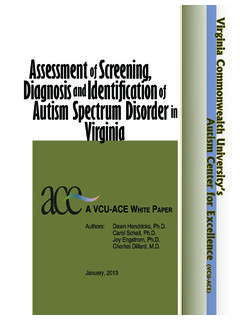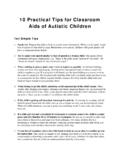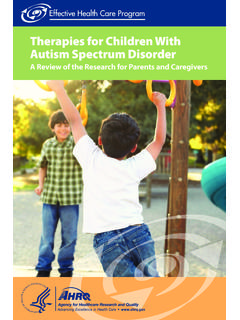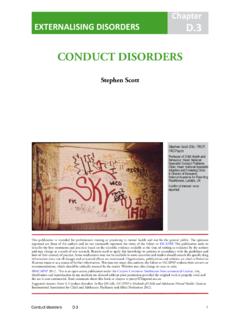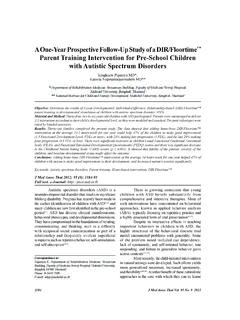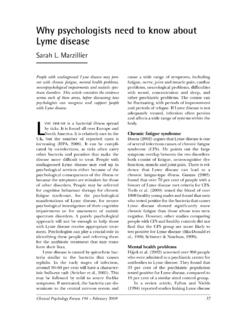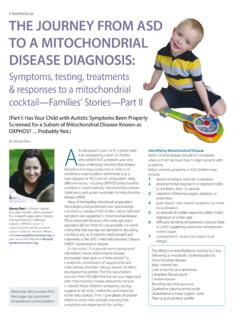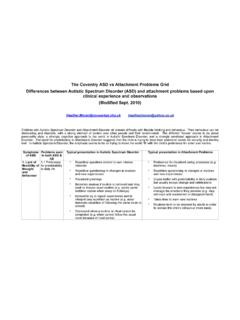Transcription of Comorbid psychopathology with autism spectrum disorder in ...
1 Comorbid psychopathology with autism spectrumdisorder in children: An overviewJohnny L. Matson*, Marie S. Nebel-SchwalmLouisiana State University, United StatesReceived 15 November 2005; accepted 22 December 2005 AbstractComorbidity, the co-occurrence of two or more disorders in the same person,has been a topic receivingconsiderable attention in the child psychopathologyliterature overall. Despitemany publications in theADHD, depression and other child literatures, autism spectrum disorder has not received such purpose of this review will be to discuss the available evidence. We address specific variables indiagnosis and classification of Comorbid symptoms, and propose potential avenues for research andpractice with respect to differential diagnosis.
2 A brief discussion of the implications for treatment is alsoprovided.#2006 Elsevier Ltd. All rights : comorbidity ; autism spectrum disorder ; PsychopathologyComorbidity, defined here as the occurrence of two or more forms of psychopathology in thesame person, has received a considerable amount of attention in the child literature. Perhaps themost prominent of these areas of research focuses on attention-deficit/hyperactivity disorder (ADHD) where comorbidity has been reported to be as high as 50% (Anderson, Williams,McGee, & Silva, 1987;Bird et al., 1988;Caron & Rutter, 1991). Similarly, for those ADHD children referred to a clinic, 87% have a Comorbid condition and 67% have two or moreadditional forms of psychopathology (Kadesjo & Gillberg, 2001).
3 Other childhood disorders have also been studied, although to a lesser ,Costello, and Erkanli (1999)for example, found that comorbidity between depression withResearch in Developmental Disabilities 28 (2007) 341 352* Corresponding author at: Department of Psychology, Louisiana State University, Baton Rouge, LA 70803, Matson).0891-4222/$ see front matter#2006 Elsevier Ltd. All rights , anxiety or conduct/oppositional defiant disorder was common. Similarly, children andadolescents with eating disorders are likely to exhibit a variety of psychopathology withcomorbidity rates as high as 90% (Lewinsohn, Striegel-Moore, & Seeley, 2000).
4 Substanceabuse, anxiety and mood disorders appear to be the most common Comorbid conditions (Grilo,Levy, Becker, Edell, & McGlashan, 1996). Perhaps not surprisingly, multiple disorders present inthe same person result in more frequent mental health referrals compared to children who evinceonly one disorder (Mash & Barkley, 2003). comorbidity in the assessment of autism spectrum disorder (ASD) is a topic that hasinfrequently been addressed, particularly when compared to the childhood disorders noted the topic has been discussed, it has often been in the context of ASD with intellectualdisability (ID) since, with the exception of Asperger s syndrome, these two conditions co-occurfrequently, and symptoms of autism , particularly language delays, stereotypies, and self-injury,increase as the severity of ID increases (Wing & Gould, 1979).
5 For the purposes of this review, wewill forgo that discussion and focus on specific forms of emotional problems and challengingbehaviors which constitute DSM-IV diagnoses, such as self-injury, stereotypies, and conductdisorder. However, the reader should be aware that disagreement exists over whether many ofthese diagnoses warrant separate categories or should be viewed as symptom clusters of ASD(AACAP, 1999). autism can be distinguished from psychosis while stereotypy and self-injuryare not differentially diagnostic between autism and ID (Matese, Matson, & Sevin, 1994;Sevinet al., 1995). Given that they are not diagnostic of ASD, but may co-occur with the disorder ,describing these behaviors as Comorbid conditions versus core features of an ASD appear to bemore consistent with the researchers have debated over whether comorbidity , at least with some disorders, hasperhaps slowed the development of knowledge in this area.
6 However, the notion that standarddiagnostic instruments should be employed to delineate impairment, including the full range ofdiagnosable disorders, has been asserted (Kazdin, 1993).Kazdin (1993)made these remarkswith respect to treatment outcome research with ASD. However, diagnosis would appear to beequally applicable with respect to this point. An additional confounding variable is thecomplexity of diagnosing ASD and its various subtypes in children, the majority of whom arealso ID (Long, Wood, & Holmes, 2000).While Asperger s does not involve ID, the more prevalent conditions of PDD and autism doinvolve high rates of the latter condition.
7 autism in particular has been studied in relationship toID and occurs in most cases (Folstein & Rutter, 1987;Ritvo et al., 1989). In the latter study, 66%of their sample of autistic children scored below 70 on an the overlap in ASD and ID, it is difficult and perhaps not particularly profitable todiscuss issues of psychopathology that occur conjointly in one of these conditions taken alone. Infact, many of the same factors that make definition and diagnosis difficult with one, applies toanother. And, with the exception of Asperger s syndrome, most cases will involve ASD and IDtogether. Second, it is asserted that diagnosing Comorbid psychopathology in these persons isappropriate, although the symptoms may vary from those seen in the general population.
8 Atpresent it seems reasonable to conclude that issues of comorbidity are poorly understood (Matson& Barrett, 1982;Ghaziuddin, Ghaziuddin, & Greden, 2002). Third, there is considerableheterogeneity in symptoms of ASD. This variability leads to additional complications regardingwhat constitutes core symptoms and whether the disorder should be conceptualized on adimensional scale with subtyping of ASD or whether distinct disorders within the continuum ofASD should be specified ( PDD-NOS, autism , Asperger s syndrome) (Sturmey & Sevin,1994;Szatmari, Volkmar, & Walter, 1995). Matson, Nebel-Schwalm / Research in Developmental Disabilities 28 (2007) 341 3523421.
9 Types of Comorbid psychopathologySporadically, papers have appeared regarding comorbidity in ASD, although they are almostexclusively about one subtype, autism . This phenomenon is related to the fact that autism hasreceived most of the research attention in the ASD spectrum literature until very recently. Evennow, the majority of published studies in ASD involve autism . Asperger s syndrome, which somedescribe as older, higher intellectually functioning persons with autism , is beginning to receivemore attention. However, by the nature of the literature, and the fact that Asperger s syndrome isoften not diagnosed until late childhood or early adolescence, the bulk of the review on ASD willbe autism studies (Howlin & Moore, 1997;Scott, Baron-Cohen, Bolton, & Brayne, 2002).
10 Wehave limited our discussion of Comorbid disorders to those discussed in the literature. Thus, whilean exhaustive list may not be presented here, those Comorbid conditions considered most relevantby ASD researchers at this time have been Mood disordersMood disorders can be broken down into major depression and bipolar disorder . Bothconditions are potentially very debilitating. Ghaziuddin and colleagues have been the mostprolific publishers to date on depression and its potential co-occurrence with autism (Ghaziuddin& Greden, 1998;Ghaziuddin, Alessi, & Greden, 1995;Ghaziuddin & Tsai, 1991;Ghaziuddin,Tsai, & Ghaziuddin, 1991). The reader is referred to these articles for a more detailed review ofthe topic.

